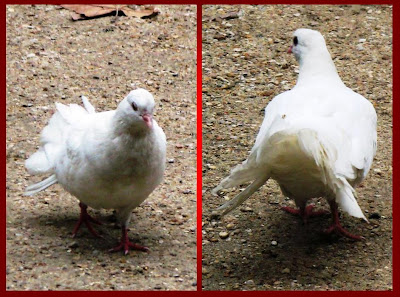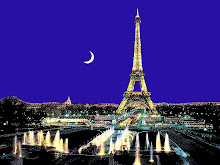St. Paul etc...
 I visited another area of Paris, hardly visited by tourists. It has anyhow its interest.
I visited another area of Paris, hardly visited by tourists. It has anyhow its interest.(The top picture is with a reference to Isabella who lives at a very nice place, Naples in Florida, although with a number of “gators” around, including on her golf course.)
 We are just south of the more visited area of “le Marais” and the “Place des Vosges”, between Rue de Rivoli and the Seine River.
We are just south of the more visited area of “le Marais” and the “Place des Vosges”, between Rue de Rivoli and the Seine River.To start with there is the St.Paul-St.Louis Church, which is beautiful and has its own interest. Completed in 1641, under Louis XIII, as a Jesuit church, it was inspired by the Gesu Church in Rome. The first mess was held by Cardinal Richelieu. It was of course pillaged and partly destroyed during the 1789 revolution and some fantastic master pieces (Dürer etc.) disappeared.
What was once the church convent is today occupied by one of the most renowned Paris schools, Lycée Charlemagne.

 Behind the church, you will find the largest remaining piece and some towers of the 12th century Philippe-August wall, which surrounded the then much smaller Paris.
Behind the church, you will find the largest remaining piece and some towers of the 12th century Philippe-August wall, which surrounded the then much smaller Paris.A later king, Charles V chose to create a residence just outside the wall (1360). This area was later occupied by simple apartment houses, which were more or less restored during the last 30 years. Here you have today a quite a nice quarter going under the name of St.Paul Village. When I visited it this week, it was extremely calm (we are still in August and Paris is to a large extent “closed”), but the place is full of high quality antique shops (obviously also a “gator” for sale – see top picture), some bars and restaurants…. You enter by a number of arched passageways and all the small streets and yards are of course open only for pedestrians.

 Around the St.Paul Village, you have a number of narrow streets, some nice recently restored flats, a censored version of Manneken Pis…
Around the St.Paul Village, you have a number of narrow streets, some nice recently restored flats, a censored version of Manneken Pis…
I wish you all a nice weekend!
You can find the original photos on my other blog - "Peter - photos".

 You may not know that the sculptor initially had the idea that a giant version of his statue should be used as a lighthouse at the entrance of the Suez Canal, then under construction.
You may not know that the sculptor initially had the idea that a giant version of his statue should be used as a lighthouse at the entrance of the Suez Canal, then under construction. The statue was completed in Paris, but was put into pieces before the transport and reassembled. It seems that the stones on which the statue is standing on Liberty Island also were coming from France.
The statue was completed in Paris, but was put into pieces before the transport and reassembled. It seems that the stones on which the statue is standing on Liberty Island also were coming from France.

 Just close to this house, you can (not) enter a private street, called Avenue Frochot, where Toulouse-Lautrec and Renoir (the painting father and the film making son) lived or worked. It seems that some of our today’s celebrities have their address here, which I believe is the reason the guard at the entrance did not want to let me in. The street looks very nice from what you can see behind the entrance gate.
Just close to this house, you can (not) enter a private street, called Avenue Frochot, where Toulouse-Lautrec and Renoir (the painting father and the film making son) lived or worked. It seems that some of our today’s celebrities have their address here, which I believe is the reason the guard at the entrance did not want to let me in. The street looks very nice from what you can see behind the entrance gate. In another small side street (Cité Monthiers; you enter from rue de Clichy) you will find a small but beautiful theatre, Théatre de l’Oeuvre (there are many other theatres around).
In another small side street (Cité Monthiers; you enter from rue de Clichy) you will find a small but beautiful theatre, Théatre de l’Oeuvre (there are many other theatres around).  I took also some pictures here and there, including the statue (with a pigeon on the top) of Hector Berlioz. All the small side streets and backyards are not that fashionable, but they have often a lot of charm... and soon they will be transformed into something fashionable and expensive.
I took also some pictures here and there, including the statue (with a pigeon on the top) of Hector Berlioz. All the small side streets and backyards are not that fashionable, but they have often a lot of charm... and soon they will be transformed into something fashionable and expensive. 




















 Below, you can see her on the left, listening to the radio, with her mother, two sisters and a brother. (They were 10 kids.)
Below, you can see her on the left, listening to the radio, with her mother, two sisters and a brother. (They were 10 kids.) She has today more or less the same haircut (it was different in between); only the hairs are a bit greyer.
She has today more or less the same haircut (it was different in between); only the hairs are a bit greyer.





 I will not throw away my old camera; it has rendered me a lot service and pleasure, but I must admit that right now I have a preference for the new one; the technical development is fast.
I will not throw away my old camera; it has rendered me a lot service and pleasure, but I must admit that right now I have a preference for the new one; the technical development is fast.
















